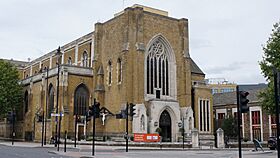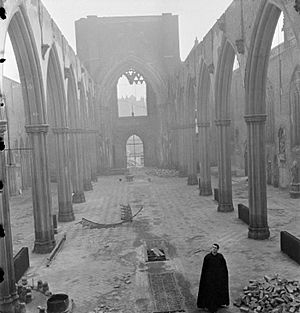St George's Cathedral, Southwark facts for kids
Quick facts for kids St George's Cathedral, Southwark |
|
|---|---|
| Metropolitan Cathedral Church of St George | |
 |
|
| Lua error in Module:Location_map at line 416: Malformed coordinates value. | |
| ACoordinates: Unknown argument format |
|
| Location | Southwark, Greater London |
| Country | England |
| Denomination | Roman Catholic |
| Tradition | Latin Rite |
| History | |
| Status | Cathedral |
| Consecrated | 1894 |
| Architecture | |
| Functional status | Active |
| Architect(s) | Augustus Welby Northmore Pugin |
| Style | Gothic Revival |
| Administration | |
| Archdiocese | Southwark |
| Province | Southwark |
St George's Cathedral, Southwark, is a very important church in south London. It is the main church for the Roman Catholic community in this area. It is also the home church for the Archbishop of Southwark.
This cathedral is the "mother church" for a large region called the Province of Southwark. This area includes all of London south of the River Thames, plus Kent and north Surrey. It also covers other important church areas like Arundel and Brighton, Portsmouth, and Plymouth. The church was first built in 1848. It had to be rebuilt in 1958 after being badly damaged during a war. Today, it is a protected building with a Grade II listing.
You can find the cathedral across from the Imperial War Museum on Lambeth Road in London. Its own primary school and the offices of CAFOD (a charity) are also nearby.
Contents
How St George's Cathedral Started
St George's Cathedral was built in 1848. It was opened by Bishop (who later became Cardinal) Nicholas Wiseman. Before this big church, local Catholics used a smaller chapel. But many Irish immigrants moved to the area, and a bigger church was needed.
In 1852, St George's became one of the first four Catholic churches in England and Wales to be called a "cathedral" again. This happened after the Catholic Church was officially re-established in England. It was the first in London to get this special status.
Who Designed the Cathedral?
The famous architect Augustus Pugin designed St George's. He was also known for his work on the Houses of Parliament in London. Pugin designed the cathedral in a style called "decorated Gothic." He used yellow bricks and Portland stone. Interestingly, Pugin himself was the first person to get married in the church on August 10, 1848.
Rebuilding After War Damage
The cathedral was severely damaged during Second World War bombings. After the war, a nearby hall was used as the main church. The architect Romilly Craze designed a new cathedral inside the remaining parts of Pugin's building. This rebuilt church opened in 1958. Some parts of Pugin's original design, like taller towers and a spire, were never built because there wasn't enough money.
Since its rebuilding, the cathedral has been a key part of the community. Many important people have visited, including the Dalai Lama in 1998 and Pope John Paul II in 1982. Pope John Paul II's visit is even shown in one of the church's beautiful stained-glass windows.
What Can You See Inside?
The cathedral has many interesting features. Before the war, it had two organs, but both were destroyed. They were replaced by a large John Compton organ in 1958. This organ has been updated since then.
Special Gifts and Connections
In 2011, the Compton organ was partly restored. Also, new choir stalls were installed. These were a gift from the Anglican St Alban's Cathedral. St George's Cathedral has strong connections with other important churches. It is linked to Paderborn Cathedral in Germany, which was also bombed during the Second World War. It also has ties to Southwark Cathedral, which is the local Anglican cathedral.
Beautiful Stained Glass
The original stained glass windows were made by William Wailes. In the rebuilt cathedral, the window above the West Door shows Mary being crowned as Queen of Heaven. The East Window shows the Crucifixion and Saints from England and Wales. Both of these beautiful windows were created by Harry Clarke of Dublin.
A Special Cross
In 2013, a cross made by the artist Fernando Llort from El Salvador was added. This cross is a special tribute to Óscar Romero, an Archbishop from San Salvador who was murdered.
Music and Choirs
The cathedral has several choirs that have been performing since 1848. They have sung at many events and their performances have even been shown on BBC Radio and TV, like the Christmas Midnight Mass in 2015.
St George's Cathedral Today
St George's Cathedral is a busy, active church for its community. For example, there is a special Mass every Sunday at 1 PM for the Latin American community, spoken entirely in Spanish. People from many different backgrounds and ages attend Mass here, including people of African, Asian, and European heritage.
The cathedral is located in a historic area. It is near the Imperial War Museum and just a short walk from London's South Bank and the River Thames. You can also easily reach Westminster Bridge, the London Eye, St Thomas' Hospital, and Waterloo station from here.
Every summer, London South Bank University uses the cathedral for its graduation ceremonies. Many orchestras and choirs also perform concerts in the main part of the church because of its great sound. The Whitehall Orchestra and Trinity College of Music often visit to perform.
Gallery
-
A shrine dedicated to Frances Xavier Cabrini, who is known as the patron saint of migrants.
See also
 In Spanish: Catedral de San Jorge (Southwark) para niños
In Spanish: Catedral de San Jorge (Southwark) para niños
- Saint George: Devotions, traditions and prayers
- List of churches and cathedrals of London









